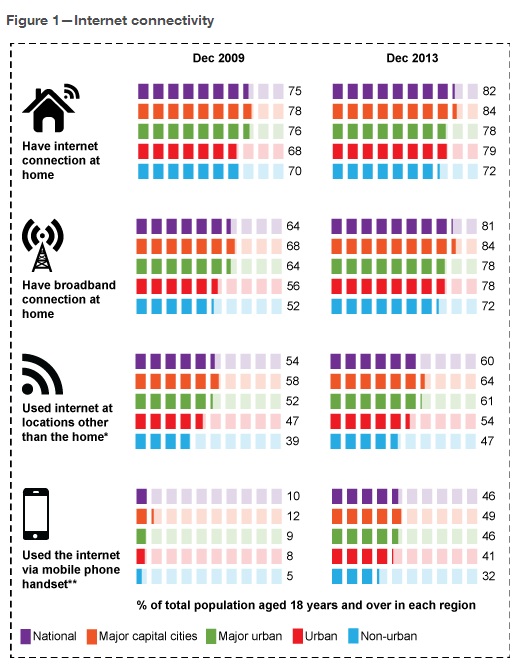Regional Australians close internet gap with mobile: ACMA

The disparity in internet usage between regional and urban Australians is swiftly closing, according to a new report by the Australian Communications and Media Authority (ACMA) — and mobile internet uptake is the driving force behind the shift.
ACMA's latest research snapshot, Regional Australia in the digital economy, shows that the use of the internet via mobile phones has seen the biggest increase across Australia, with mobile phone internet services typically being used as a complementary service to a home internet connection.
The report, released today, reveals that regional Australians are now nearly as active online as other Australians, reflecting the increasing importance of the internet and online service delivery in their daily lives.
Among the estimated 40 percent of Australians that live outside of the country's six largest cities, ACMA reported a "huge" jump in the use of mobile phone internet services.

In communities with less than 1,000 people, one in three adults went online using their mobile phone during December 2013, compared to just one in 20, four years earlier.
Nationally, 46 per cent of adults used the internet on their mobiles during December 2013 compared to just ten per cent during December 2009.
Streaming has been the most prominent development in online entertainment activities, according to the research, with the number of Australians who directly stream content overtaking those downloading content.
ACMA said that more Australians in communities with less than 1,000 people are going online at multiple locations, with 18 per cent of adult internet users in these communities going online from three or more separate locations such as home, work, school, the library or a wireless hot spot as at December 2013 compared to 12 percent at December 2009.
Meanwhile, 46 per cent of adult internet users in communities with less than 1,000 people went online more than once a day at December 2013 compared with 33 per cent at June 2009.
ACMA said that, across all regions, Australians were diversifying their online activities to include email, research, banking, entertainment, blogging, and social networking.
The research found that regional Australians were also becoming more intensive users of the internet, with nearly six in ten adult internet users in communities with fewer than 1000 people undertaking five or more separate activities online during December last year compared to thee in ten during December 2009.
ACMA found that although regional disparities in participation levels do still exist, the gap is closing in some areas, with internet users in major urban areas only slightly behind their major capital city counterparts in levels of internet connectivity and frequency of internet use. They are equal in terms of intensity of online participation.
"What this study shows is that mobile connectivity is an indispensable feature of everyday life for people living in rural and regional Australia," said parliamentary secretary to the minister for communications Paul Fletcher.
The ACMA findings come as the Department of Communications revealed that it has already received around 4,000 reported mobile coverage black spots in regional Australia in its national Mobile Black Spot Programme.
"As at 29 May 2014, around 3000 locations across Australia reported as having poor or no mobile coverage were captured on the Department’s database. As at mid-July this number had increased to around 4,000 reported black spot locations," the department said in response (PDF) to a query during a Budget Estimates hearing in May.
The department said the database and its black spot records will be provided to potential applications, including Telstra, Optus, and Vodafone Hutchison Australia, to assist them in preparing their funding bids for the Mobile Black Spot Programme.
The government outlined its plan in May's Federal Budget to spend AU$100 million over the next four years on its Mobile Black Spot Programme, aimed at addressing regional mobile coverage shortfalls.
"I have visited over 30 electorates and taken part in more than 50 community meetings around Australia as we prepare to roll out the Abbott Government's AU$100 million Mobile Black Spot Programme," said Fletcher. "The message I keep hearing is that mobile connectivity is essential for business, education, tourism, emergency services, and in response to natural disasters — particularly for people in small communities.
"The government expects to fund 250-300 new mobile base stations around Australia under the programme. We will commence a competitive selection process in the second half of this year, with a view to announcing the locations which have been selected for funding in the first half of 2015.
"The government anticipates that the first base stations funded under the programme will begin to roll out in the second half of 2015," he said.